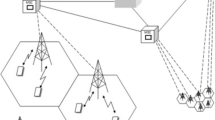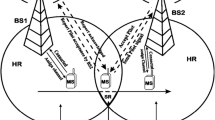Abstract
In this paper we suggest a call admission control (CAC) algorithm for high speed downlink packet access HSDPA UMTS systems. In this algorithm the user requesting admission is gradually admitted into the system. This is done by setting a back-off factor limiting the new user’s throughput. The back-off factor is gradually decreased leading to a gradual increase in the new user’s throughput until it is fully integrated into the system. The back-off factor works on protecting the active links in a way that their rates do not drop below a guaranteed quality of service (QoS) level.
Similar content being viewed by others
References
Bender, P., Black, P., Grob, M., Padovani, R., Sindhushayana, N., & Viterbi, A. (2000). CDMA/HDR: A bandwidth-efficient high-speed wireless data service for nomadic users. IEEE Communications Magazine, 38, 70–77.
Parkvall, S., Dahlman, E., Frenger, P., Beming, P., & Persson, M. (2001). The high speed packet data evolution of WCDMA. In Proc. IEEE VTC (Vol. 3, pp. 2287–2291). Spring.
Berggren, F., & Jäntti, R. (2004). Asymptotically fair transmission scheduling over fading channels. IEEE Transactions on Wireless Communications, 3, 326–336.
Knopp, R., & Humblet, P. A. (1995). Multiple accessing over frequency selective fading channels. In Proceedings of IEEE PIMRC 1995 (Vol. 3, pp. 1326–1330), Canada, September.
Jalali, A., Padovani, R., & Pankaj, R. (2000). Data throughput of CDMA-HDR: A high efficiency-high data rate personal communication wireless system. In IEEE 51st vehicular technology conference (Vol. 3, pp. 1854–1858). Tokyo, Japan, May.
Shakkottai, S., & Stolyar, A. L. (2000). Scheduling for multiple flows sharing a time varying channel: the exponential rule (Technical Report). Bell Laboratories.
Shakkottai, S., & Stolyar, A. (2001). Scheduling algorithms for a mixture of real-time and non-real-time data in HDR. In Proc. Int. Teletrafic Congress (pp. 793–804).
Chang, K., & Han, Y. (2002). QoS-based adaptive scheduling for a mixed service in HDR system. In Proc. IEEE PIMRC (Vol. 4, pp. 1914–1918).
Liu, X., Chong, E. K. P., & Shroff, N. B. (2001). Transmission scheduling for efficient wireless resource utilization with minimum-performance guarantees. In Proc. IEEE VTC2001 (Vol. 2, pp. 824–838). Fall.
Zhao, P., & Zhang, H. M. (2002). Sliding window based CAC for adaptive service in mobile network. In Proc. IEEE PIMRC (Vol. 5, pp. 2165–2169).
Bambos, B., Chen, S. C., & Pottie, G. J. (2000). Channel access algorithms with active link protection for wireless communication networks with power control. IEEE/ACM Transactions on Networking, 8, 583–597.
Park, D., Seo, H., Kwon, H., & Lee, B. (2003). A new wireless packet scheduling algorithm based on the CDF of user transmission rates. In Proc. IEEE GLOBECOM (pp. 528–532).
Stolyar, A. (2005). On the asymptotic optimality of the gradient scheduling algorithm for multiuser throughput allocation. Operations Research, 53(1), 12–25.
Gribanova, K. (2004). Packet scheduling for video streaming data in the HDR system. Master’s thesis, Telecommunication software and multimedia laboratory, Helsinki University of Technology.
Jakes, W. C. (2001). Microwave mobile communications. New York: Wiley, Sect. 1.7.2.
Pop, & Beaulieu (2001). Limitations of sum of sinusoids fading simulator simulators. IEEE Transactions on Communications, 49, 669–708.
Author information
Authors and Affiliations
Corresponding author
Rights and permissions
About this article
Cite this article
Al-Rawi, M., Jäntti, R. Call admission control with active link protection for opportunistic wireless networks. Telecommun Syst 41, 13–23 (2009). https://doi.org/10.1007/s11235-009-9147-z
Published:
Issue Date:
DOI: https://doi.org/10.1007/s11235-009-9147-z




